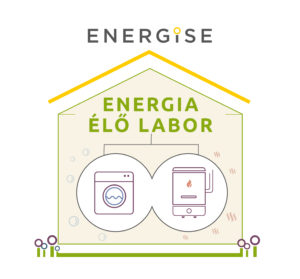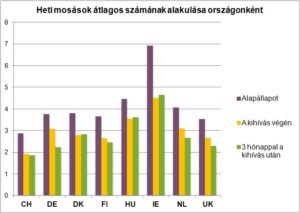

In response to the increasingly urgent climate crisis, the European Commission is promoting several climate and energy targets with the goal of reducing greenhouse gas emissions and decarbonising the economy. However, the current pace and scale of change is insufficient to achieve the necessary sustainability transitions in energy systems. Increasingly, households are seen as playing a role in energy transitions – which implies challenging social norms and habits around energy usage in the home.

As part of an innovative research initiative, the ENERGISE consortium launched Energy Living Labs to develop and test options for changing energy use in households in 8 countries[i]. Energy Living Labs were implemented among over 300 households from September to December 2018.
The ENERGISE study proves that reductions in energy use are possible when people are given the time and space to question their usual practices, as they experiment with departing from what could be considered the norm and try out ways of doing things differently. This approach is in stark contrast to approaches centred on individual or technological change, which the ENERGISE team has shown to dominate initiatives aimed at changing household energy use, and which fail to address the complex interactions and social norms that make up everyday life.
Based on the outcomes of the ENERGISE Living Labs, in order to help the transition to low-carbon lifestyles the following should be
It has been shown that more efficient technology is not enough to reduce energy consumption. People need to be engaged and empowered to use them, and even more so to become aware of and challenge their energy use practices, and try out new ways of doing things. For example, try out new programmes on their washing machine and measure their energy consumption, wash spots rather than the whole clothing item, put on extra layers or use blankets instead of turning up the thermostat, etc.. This is impactful in terms of reducing energy consumption.
Creating opportunities to reflect, and inviting actors, e.g. households, experts, energy companies, and policy makers, to discuss norms, rules, etc. around energy use can be very effective for challenging what tend to be tacitly accepted norms and assumptions around consumption practices.
It must be ensured that people can continue to have an influence on their thermal comfort, rather than counting on smart buildings or invisible heating systems that allow only limited human interventions. Similarly, washing machines need to be designed in a way to allow for transparency on the energy and water use of programmes as well as for users to navigate easily between them and thus influence their environmental impact.
But how did the ENERGISE Living Labs work and what were there main quantitative outcomes?
Participating households agreed to engage in two main challenges:
These challenges were co-designed to create a disruption in everyday life, involving habits and routines that can be difficult to change. Specific attention was given to the social norms tied up with laundry and heating: When do we decide to put clothes to wash? How can we feel comfortable at home without turning up the heat? Rather than start with the question of technological efficiency or financial considerations, the project focused on social norms, skills, competencies, materials and infrastructures in daily energy use. Local teams guided households in all 8 countries through the same multi-method living lab process, which involved giving support and encouraging learning through using energy- and thermo-meters; laundry and heating diaries; challenge kits, tips, discussions, etc. to support the change of energy use practices.
Through the Living Labs the ENERGISE team found that reducing indoor temperatures by 1°C in the heating season and reducing laundry by one cycle per week is possible, without compromising convenience and comfort[ii]. In some cases, reductions were even more significant, and in many instances, changes were maintained for three months after the challenges when the ENERGISE team conducted a follow-up study. As shown in the graph, the average number of laundry cycles per week decreased in all countries, and did not return to the original number even after the challenge finished.[iii] In fact, in many households it continued to decrease.

The table below displays the self-reported average quantitative change as a result of the Living Labs for laundry and heating:[iv]
| Average changes in reported temperatures and laundry cycles during ELLs | ||||
| Change in temperatures | Change in weekly laundry cycles | |||
| Living room | Bedroom | For all households | Family of 2 | Family of 4 |
| From 21.1°C to 20.1°C | From 20.0°C to 18.6°C | From 4.2 to 3.1 | From 4.3 to 3.2 | From 4.1 to 3.0 |
| 1°C less | 1.4°C less | 1.1 cycles less
(26% reduction) |
1.1 cycle less (26% reduction) | 1.1 cycle less (26% reduction) |
| Data source: weekly surveys; averages taken before challenges, and during challenges | ||||
If implemented at the societal level and across all households in Europe, the energy savings could be significant. For example, one less laundry cycle per week in Swiss households for a year represents a saving of around 13 million m3 of water, 10 million liters of laundry products and the equivalent annual electricity consumption of 90,000 households – if implemented by all Swiss households. One less laundry cycle per week is also estimated at saving one hour of domestic work per week. And a 1 °C drop in room temperature, during the winter months when buildings are heating, results in an estimated saving of 6% of all energy dedicated to heating homes in Switzerland.[v]

EPA Research team and Directors.
Picture Fennell Photography – Copyright Fennell Photography 2017.
[i] Denmark, Finland, Germany, Hungary, Ireland, Switzerland, the Netherlands, the United Kingdom
[ii] While ENERGISE recognises that all sectors of society have a role to play in energy transitions, not solely households, we found that when it comes to households, absolute reductions in temperature settings are possible – assuming that households have an observed indoor temperature that was higher than the targeted reduction of 18 degrees. The average temperatures recorded prior to the challenge were closer to 20 degrees. Thus, we exclude from this finding households who were already experiencing low indoor temperatures, whether out of preference and habit, or due to energy poverty in terms of accessing affordable energy.
[iii] When the number of laundry cycles varies across countries, it is primarily due to a varied composition of households in the national samples. Source: Report on analysis of ENERGISE Living Labs (D5.2)
[iv] Source: Report on analysis of ENERGISE Living Labs (D5.2)
[v] Source: Report on analysis of ENERGISE Living Labs (D5.2)